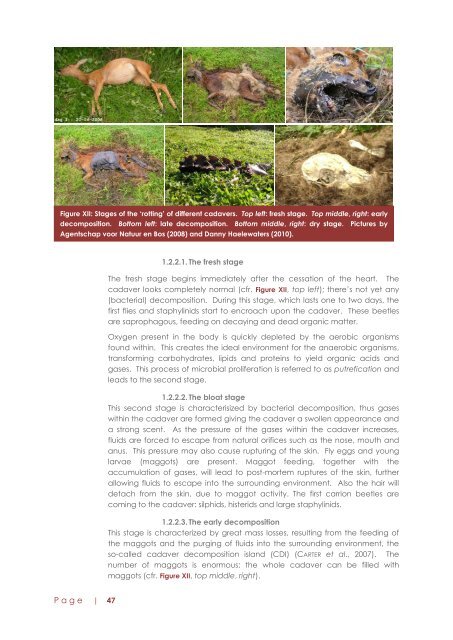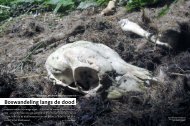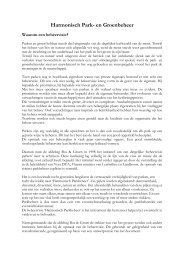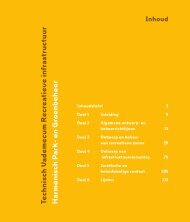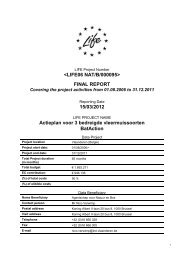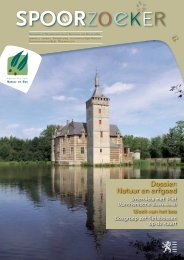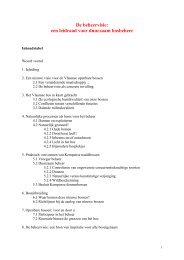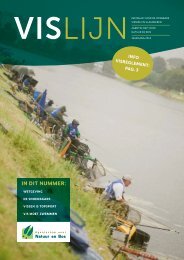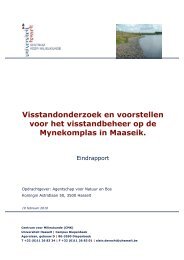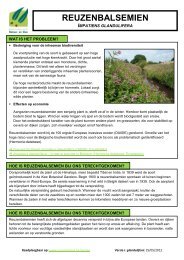Figure XII: Stages of the „rotting‟ of differ<strong>en</strong>t cadavers. Top left: fresh stage. Top middle, right: earlydecomposition. Bottom left: late decomposition. Bottom middle, right: dry stage. Pictures by<strong>Ag<strong>en</strong>tschap</strong> <strong>voor</strong> <strong>Natuur</strong> <strong>en</strong> <strong>Bos</strong> (2008) and Danny Haelewaters (2010).1.2.2.1. The fresh stageThe fresh stage begins immediately after the cessation of the heart. Thecadaver looks completely normal (cfr. Figure XII, top left); there‟s not yet any(bacterial) decomposition. During this stage, which lasts one to two days, thefirst flies and staphylinids start to <strong>en</strong>croach upon the cadaver. These beetlesare saprophagous, feeding on decaying and dead organic matter.Oxyg<strong>en</strong> pres<strong>en</strong>t in the body is quickly depleted by the aerobic organismsfound within. This creates the ideal <strong>en</strong>vironm<strong>en</strong>t for the anaerobic organisms,transforming carbohydrates, lipids and proteins to yield organic acids andgases. This process of microbial proliferation is referred to as putrefication andleads to the second stage.1.2.2.2. The bloat stageThis second stage is characterisized by bacterial decomposition, thus gaseswithin the cadaver are formed giving the cadaver a swoll<strong>en</strong> appearance anda strong sc<strong>en</strong>t. As the pressure of the gases within the cadaver increases,fluids are forced to escape from natural orifices such as the nose, mouth andanus. This pressure may also cause rupturing of the skin. Fly eggs and younglarvae (maggots) are pres<strong>en</strong>t. Maggot feeding, together with theaccumulation of gases, will lead to post-mortem ruptures of the skin, furtherallowing fluids to escape into the surrounding <strong>en</strong>vironm<strong>en</strong>t. Also the hair willdetach from the skin, due to maggot activity. The first carrion beetles arecoming to the cadaver: silphids, histerids and large staphylinids.1.2.2.3. The early decompositionThis stage is characterized by great mass losses, resulting from the feeding ofthe maggots and the purging of fluids into the surrounding <strong>en</strong>vironm<strong>en</strong>t, theso-called cadaver decomposition island (CDI) (CARTER et al., 2007). Th<strong>en</strong>umber of maggots is <strong>en</strong>ormous: the whole cadaver can be filled withmaggots (cfr. Figure XII, top middle, right).P a g e | 47
Differ<strong>en</strong>t groups of carrion beetles attain their maximum d<strong>en</strong>sities. The actualdecomposition of a corpse is a bacterial process which requires oxyg<strong>en</strong>. Onlywh<strong>en</strong> the cadaver is riddled by the activity of insects (maggots), oxyg<strong>en</strong> isable to reach the interior; aerobic microorganisms can do their work anddecomposition begins. The internal temperature increases significantly abovethe ambi<strong>en</strong>t temperature (MELIS et al., 2004), therefore creating amicroclimatic patch. The cadaver is starting to look very dirty now. Body fluidsare abundantly released, the skin detaches.1.2.2.4. The late decompositionIn this stage, all the meat has gone and the skin has completely released. Themaggots are migrating away from the cadaver to pupate (cfr. Figure XII,bottom left). Large staphylinids predate on the remaining maggots and largescav<strong>en</strong>gers – fox, wild boar, badger, rav<strong>en</strong> – appear around the cadaver.After three to nine weeks, the cadaver is largely desintegrated.The CDI will display an increase of soil carbon and nutri<strong>en</strong>ts.1.2.2.5. The dry stageThe last stage begins wh<strong>en</strong> the last maggot leaves the cadaver. All thatremains is hard, dry skin, cartilage and bones (cfr. Figure XII, bottom right).Some specialized fungi, such as hoof fungus (Onyg<strong>en</strong>a equina), can <strong>en</strong>d upupon the remains. Until now, little is known about this. The remaining bonesare a rich source of calcium and phosphorus for animals.If all soft tissue has be<strong>en</strong> removed from the cadaver, it will be referred to ascompletely skeletonized.Dep<strong>en</strong>ding on the temperature, humidity, body volume and activity ofscav<strong>en</strong>gers, the „rotting‟ process takes several weeks to many months.Until now, few is known about possible prefer<strong>en</strong>ces of beetles associated withdecomposing cadavers of specific species. More research and moreover acomparative study betwe<strong>en</strong> carrion beetles upon cadavers of deer, foxes,pigs and other species is needed.It is worth studying cadavers, at least if no artificial interv<strong>en</strong>tions occur: thebody should remain as intact as possible, free from any human disturbance.This way large numbers of insects and scav<strong>en</strong>gers can be observed and animpression of the natural succession of species can be obtained (VAN WIELINK,2004).1.2.3. PROJECT DOOD DOET LEVENIn june 2008, <strong>Ag<strong>en</strong>tschap</strong> <strong>voor</strong> Nauur <strong>en</strong> <strong>Bos</strong> started the project Dood doetLev<strong>en</strong> in the Sonian Forest, in addition to a similar project in the naturallandscape Ooijpolder (Nijmeg<strong>en</strong>, The Netherlands). Rec<strong>en</strong>tly, the NationalInstitute for Criminalistics and Criminology (Brussels, Belgium) became a partnerof the project.P a g e | 48
- Page 3: LABOULBENIALESEXPLORING AND TESTING
- Page 7 and 8: PART IVPRELIMINARY CHECKLIST OF LAB
- Page 9 and 10: SAMENVATTINGINLEIDINGLaboulbeniales
- Page 11 and 12: PART IGENERAL INTRODUCTIONTHESIS OU
- Page 13 and 14: fifth volume, therefore the sixth v
- Page 16 and 17: 1.3.3. THE PERITHECI UMAscospores o
- Page 18 and 19: The identity of appendages, togethe
- Page 20 and 21: Figure IV: Position of Laboulbeniom
- Page 22 and 23: LUMBSCH & HUHNDORF (2007) distingui
- Page 25 and 26: Substrate is the intermediate facto
- Page 27: CAVARA (1899, ref. in BENJAMIN, 197
- Page 35 and 36: 1. INTRODUCTION1.1. DIFFICULTIES FO
- Page 37 and 38: 2. MATERIALS & METHODS2.1. FUNGUS,
- Page 39 and 40: 2.2.6. PROTOCOL V: DIRECT PCROne th
- Page 41 and 42: P a g e | 38chance. Thus, the lower
- Page 43 and 44: coll1133 Laboulbenia collae IV 608l
- Page 45 and 46: Cladosporium (Ascomycota, Dothideom
- Page 47 and 48: 5. CONCLUSION AND SUGGESTIONSMany a
- Page 49: 1. INTRODUCTION1.1. FORENSIC ENTOMO
- Page 53 and 54: The 1.319 ha Meerdaal Forest has be
- Page 55 and 56: 2.2. MEERDAAL FOREST(DA TA NA TI O
- Page 57 and 58: approximately 2.700 are found in Eu
- Page 59 and 60: Order ColeopteraSuborder PolyphagaI
- Page 61 and 62: Dermestidae 8 2 23 (3) / 22 (4)Elat
- Page 63 and 64: Table XXIV: Family Cerambycidae fro
- Page 65 and 66: Table XXVIII: Family Dermestidae fr
- Page 67 and 68: Adults prey on other flower-visitin
- Page 69 and 70: Table XXXV: Family Scarabaeidae fro
- Page 71 and 72: Creophilus Samouellemaxillosus (Lin
- Page 73 and 74: 4.3. LABOULBENIALES OF CARRION BEET
- Page 75 and 76: The knowledge about the preferences
- Page 77 and 78: Table XLII: Comparison of carrion b
- Page 79 and 80: 5. CONCLUSION AND SUGGESTIONSNo spe
- Page 81 and 82: 1. INTRODUCTION1.1. NATURAL LANDSCA
- Page 83 and 84: In the 40s, Middelhoek studied and
- Page 85 and 86: 2. MATERIALS & METHODS2.1. HOSTS2.1
- Page 87 and 88: Screening of the insects was done w
- Page 89 and 90: 3. RESULTS3.1. PARASITE-HOST LISTA
- Page 91 and 92: Figure XV: Detail of thallus of Lab
- Page 93 and 94: isodiametric or slightly elongate,
- Page 95 and 96: occurs in the lower receptacle (cel
- Page 97 and 98: Discussion:Two species of the genus
- Page 99 and 100: anches (15-)34-38(-40) µm long, te
- Page 101 and 102:
5. CONCLUSION AND SUGGESTIONSIn The
- Page 103 and 104:
P a g e | 100ADRIAENS, T. & GYSELS,
- Page 105 and 106:
transmission, habitat preference an
- Page 107 and 108:
STALPERS, J.A., VILGALYS, R., AIME,
- Page 109 and 110:
MELIS, C., TEURLINGS, I. LINNELL, J
- Page 111 and 112:
SCHILTHUIZEN, M. & VALLENDUUK, H. (


